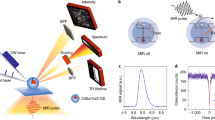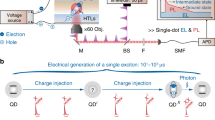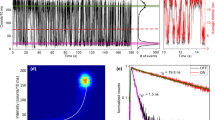Abstract
Photoluminescence blinking—random switching between states of high (ON) and low (OFF) emissivities—is a universal property of molecular emitters found in dyes1, polymers2, biological molecules3 and artificial nanostructures such as nanocrystal quantum dots, carbon nanotubes and nanowires4,5,6. For the past 15 years, colloidal nanocrystals have been used as a model system to study this phenomenon5,6. The occurrence of OFF periods in nanocrystal emission has been commonly attributed to the presence of an additional charge7, which leads to photoluminescence quenching by non-radiative recombination (the Auger mechanism)8. However, this ‘charging’ model was recently challenged in several reports9,10. Here we report time-resolved photoluminescence studies of individual nanocrystal quantum dots performed while electrochemically controlling the degree of their charging, with the goal of clarifying the role of charging in blinking. We find that two distinct types of blinking are possible: conventional (A-type) blinking due to charging and discharging of the nanocrystal core, in which lower photoluminescence intensities correlate with shorter photoluminescence lifetimes; and a second sort (B-type), in which large changes in the emission intensity are not accompanied by significant changes in emission dynamics. We attribute B-type blinking to charge fluctuations in the electron-accepting surface sites. When unoccupied, these sites intercept ‘hot’ electrons before they relax into emitting core states. Both blinking mechanisms can be electrochemically controlled and completely suppressed by application of an appropriate potential.
This is a preview of subscription content, access via your institution
Access options
Subscribe to this journal
Receive 51 print issues and online access
$199.00 per year
only $3.90 per issue
Buy this article
- Purchase on Springer Link
- Instant access to full article PDF
Prices may be subject to local taxes which are calculated during checkout





Similar content being viewed by others
References
Hoogenboom, J. P., Hernando, J., van Dijk, E. M. H. P., van Hulst, N. F. & García-Parajó, M. F. Power-law blinking in the fluorescence of single organic molecules. ChemPhysChem 8, 823–833 (2007)
Bout, D. A. V. et al. Discrete intensity jumps and intramolecular electronic energy transfer in the spectroscopy of single conjugated polymer molecules. Science 277, 1074–1077 (1997)
Riley, E. A., Bingham, C., Bott, E. D., Kahr, B. & Reid, P. J. Two mechanisms for fluorescence intermittency of single violamine R molecules. Phys. Chem. Chem. Phys. 13, 1879–1887 (2011)
Frantsuzov, P., Kuno, M., Janko, B. & Marcus, R. A. Universal emission intermittency in quantum dots, nanorods and nanowires. Nature Phys. 4, 519–522 (2008)
Nirmal, M. et al. Fluorescence intermittency in single cadmium selenide nanocrystals. Nature 383, 802–804 (1996)
Fernando, D. Stefani, J. P. H. & Barkai, E. Beyond quantum jumps: blinking nanoscale light emitters. Phys. Today 6, 34–39 (2009)
Efros, A. L. & Rosen, M. Random telegraph signal in the photoluminescence intensity of a single quantum dot. Phys. Rev. Lett. 78, 1110–1113 (1997)
Klimov, V. I., Mikhailovsky, A. A., McBranch, D. W., Leatherdale, C. A. & Bawendi, M. G. Quantization of multiparticle Auger rates in semiconductor quantum dots. Science 287, 1011–1013 (2000)
Zhao, J., Nair, G., Fisher, B. R. & Bawendi, M. G. Challenge to the charging model of semiconductor-nanocrystal fluorescence intermittency from off-state quantum yields and multiexciton blinking. Phys. Rev. Lett. 104, 157403 (2010)
Rosen, S., Schwartz, O. & Oron, D. Transient fluorescence of the off state in blinking CdSe/CdS/ZnS semiconductor nanocrystals is not governed by Auger recombination. Phys. Rev. Lett. 104, 157404 (2010)
Fisher, B. R., Eisler, H.-J., Stott, N. E. & Bawendi, M. G. Emission intensity dependence and single-exponential behavior in single colloidal quantum dot fluorescence lifetimes. J. Phys. Chem. B 108, 143–148 (2004)
Zhang, K., Chang, H., Fu, A., Alivisatos, A. P. & Yang, H. Continuous distribution of emission states from single CdSe/ZnS quantum dots. Nano Lett. 6, 843–847 (2006)
García-Santamaría, F. et al. Breakdown of volume scaling in Auger recombination in CdSe/CdS heteronanocrystals: the role of the core−shell interface. Nano Lett. 11, 687–693 (2011)
Gómez, D. E., van Embden, J., Mulvaney, P., Fernee, M. J. & Rubinsztein-Dunlop, H. Exciton−trion transitions in single CdSe–CdS core–shell nanocrystals. ACS Nano 3, 2281–2287 (2009)
Jha, P. P. & Guyot-Sionnest, P. Trion decay in colloidal quantum dots. ACS Nano 3, 1011–1015 (2009)
Houtepen, A. J. & Vanmaekelbergh, D. Orbital occupation in electron-charged CdSe quantum-dot solids. J. Phys. Chem. B 109, 19634–19642 (2005)
Jha, P. P. & Guyot-Sionnest, P. Electrochemical switching of the photoluminescence of single quantum dots. J. Phys. Chem. C 114, 21138–21141 (2010)
Chen, Y. et al. “Giant” multishell CdSe nanocrystal quantum dots with suppressed blinking. J. Am. Chem. Soc. 130, 5026–5027 (2008)
Wang, X. et al. Non-blinking semiconductor nanocrystals. Nature 459, 686–689 (2009)
Klimov, V. I., McGuire, J. A., Schaller, R. D. & Rupasov, V. I. Scaling of multiexciton lifetimes in semiconductor nanocrystals. Phys. Rev. B 77, 195324 (2008)
McGuire, J. A. et al. Spectroscopic signatures of photocharging due to hot-carrier transfer in solutions of semiconductor nanocrystals under low-intensity ultraviolet excitation. ACS Nano 4, 6087–6097 (2010)
Tisdale, W. A. et al. Hot-electron transfer from semiconductor nanocrystals. Science 328, 1543–1547 (2010)
Li, S., Steigerwald, M. L. & Brus, L. E. Surface states in the photoionization of high-quality CdSe core/shell nanocrystals. ACS Nano 3, 1267–1273 (2009)
Jeong, S. et al. Effect of the thiol−thiolate equilibrium on the photophysical properties of aqueous CdSe/ZnS nanocrystal quantum dots. J. Am. Chem. Soc. 127, 10126–10127 (2005)
Hohng, S. & Ha, T. Near-complete suppression of quantum dot blinking in ambient conditions. J. Am. Chem. Soc. 126, 1324–1325 (2004)
Fomenko, V. & Nesbitt, D. J. Solution control of radiative and nonradiative lifetimes: a novel contribution to quantum dot blinking suppression. Nano Lett. 8, 287–293 (2008)
Jin, S., Song, N. & Lian, T. Suppressed blinking dynamics of single QDs on ITO. ACS Nano 4, 1545–1552 (2010)
Tyagi, P. & Kambhampati, P. False multiple exciton recombination and multiple exciton generation signals in semiconductor quantum dots arise from surface charge trapping. J. Chem. Phys. 134, 094706 (2011)
Li, J. J. et al. Large-scale synthesis of nearly monodisperse CdSe/CdS core/shell nanocrystals using air-stable reagents via successive ion layer adsorption and reaction. J. Am. Chem. Soc. 125, 12567–12575 (2003)
Vela, J. et al. Effect of shell thickness and composition on blinking suppression and blinking mechanism in ‘giant’ CdSe/CdS nanocrystal quantum dots. J. Biophoton. 3, 706–717 (2010)
Yu, W. W., Qu, L., Guo, W. & Peng, X. Experimental determination of the extinction coefficient of CdTe, CdSe, and CdS nanocrystals. Chem. Mater. 15, 2854–2860 (2003)
Juris, A. et al. Ru(II) polypyridine complexes: photophysics, photochemistry, eletrochemistry, and chemiluminescence. Coord. Chem. Rev. 84, 85–277 (1988)
DeLaive, P. J., Foreman, T. K., Giannotti, C. & Whitten, D. G. Photoinduced electron transfer reactions of transition-metal complexes with amines. Mechanistic studies of alternate pathways to back electron transfer. J. Am. Chem. Soc. 102, 5627–5631 (1980)
Park, Y. S. et al. Near-unity quantum yields of biexciton emission from CdSe/CdS nanocrystals measured using single-particle spectroscopy. Phys. Rev. Lett. 106, 187401 (2011)
Acknowledgements
C.G. and V.I.K. acknowledge support of the Center for Advanced Solar Photophysics, an Energy Frontier Research Center funded by the US Department of Energy (DOE), Office of Science, Office of Basic Energy Sciences (BES). Y.G. and A.S. are supported by Los Alamos National Laboratory Directed Research and Development Fund. M.S., J.A.H. and H.H. are supported by NIH-NIGMS grant 1R01GM084702–01. This work was conducted, in part, at the Center for Integrated Nanotechnologies, a DOE/BES user facility.
Author information
Authors and Affiliations
Contributions
C.G., M.S., J.A.H., V.I.K. and H.H. conceived the study. C.G., M.S. and H.H. designed the experiments. C.G. constructed the experimental set-up and performed the measurements under the guidance of M.S., V.I.K. and H.H. Y.G. synthesized and A.S. modified quantum dot materials under the guidance of J.A.H. C.G., V.I.K. and H.H. analysed and interpreted the data, and wrote the manuscript with the assistance of all other co-authors.
Corresponding authors
Ethics declarations
Competing interests
The authors declare no competing financial interests.
Supplementary information
Supplementary Information
This file contains Supplementary Text and Data 1-4, additional references, Supplementary Figures 1-13 with legends and Supplementary Tables 1-2. (PDF 1111 kb)
Rights and permissions
About this article
Cite this article
Galland, C., Ghosh, Y., Steinbrück, A. et al. Two types of luminescence blinking revealed by spectroelectrochemistry of single quantum dots. Nature 479, 203–207 (2011). https://doi.org/10.1038/nature10569
Received:
Accepted:
Published:
Issue Date:
DOI: https://doi.org/10.1038/nature10569
This article is cited by
-
Single quantum dot spectroscopy for exciton dynamics
Nano Research (2024)
-
Electric-field-induced colour switching in colloidal quantum dot molecules at room temperature
Nature Materials (2023)
-
Post-processing of real-time quantum event measurements for an optimal bandwidth
Scientific Reports (2023)
-
Unveiling non-radiative center control in CsPbBr3 nanocrystals: A comprehensive comparative analysis of hot injection and ligand-assisted reprecipitation approaches
Nano Research (2023)
-
Lattice distortion inducing exciton splitting and coherent quantum beating in CsPbI3 perovskite quantum dots
Nature Materials (2022)
Comments
By submitting a comment you agree to abide by our Terms and Community Guidelines. If you find something abusive or that does not comply with our terms or guidelines please flag it as inappropriate.



